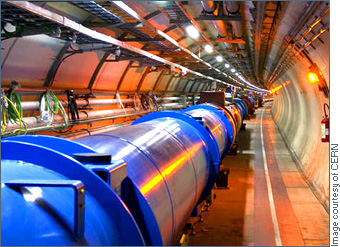Large Hadron Collider and New Developments in Dark Matter Focus of NYU Workshop, Aug. 3
July 30, 2009
The following media advisory, distributed by New York University, invites the public to the first day of a workshop about the latest developments at CERN’s Large Hadron Collider (LHC). In addition to serving as the U.S. host laboratory for the LHC’s ATLAS experiment, Brookhaven plays multiple roles in this massive international undertaking, ranging from construction and project management to data storage and distribution. For more information about Brookhaven's contributions, please visit www.bnl.gov/atlas or contact Kendra Snyder at ksnyder@bnl.gov or 631-344-8191.

The LHC tunnel
New York University will host a public workshop to provide an overview of the Large Hadron Collider, featured in this summer’s “Angels & Demons,” on Monday, August 3, 9 a.m.-5 p.m., at NYU’s Kimmel Center for University Life, Eisner and Lubin Auditorium (60 Washington Square South [at LaGuardia Place], 4th Floor).
Reporters interested in attending the session must RSVP to James Devitt, NYU’s Office of Public Affairs, at 212.998.6808 or james.devitt@nyu.edu. (See conference agenda.)
In addition to a summary of developments at the 17-mile Large Hadron Collider (LHC), the session will include a presentation by NYU physicist Neal Weiner describing recent experimental findings and new theoretical ideas on dark matter as well as how it may appear at the LHC. Dark matter, which makes up a large proportion of the universe, has thus far only been detected by its gravitational pull. Other presenters include: Fabiola Gianotti, a particle physicist at the CERN laboratory; Stanford Physics Professor Michael Peskin; and Matt Strassler, a theoretical physicist at Rutgers University.
Located at the CERN laboratory near Geneva, Switzerland, LHC is the world’s most powerful particle accelerator. An estimated 10,000 people from 60 countries have helped design and build the accelerator and its massive particle detectors, including more than 1,700 scientists, engineers, students and technicians from 94 U.S. universities and laboratories supported by the U.S. Department of Energy’s Office of Science and the National Science Foundation.
The project’s ultimate goal is to generate high-energy beams colliding in the centers of the LHC’s particle detectors. The scientists participating in these experiments are analyzing these collisions in search of discoveries about the nature of the physical universe. The debris of the collisions reveals the nature of fundamental particle processes and may also contain as-yet undiscovered particles.
The energy density in these collisions is similar to that of the early universe less than a billionth of a second after the Big Bang. Beyond revealing a new world of unknown particles, the LHC experiments could explain why those particles exist and behave as they do. They could reveal the origins of mass, shed light on dark matter, uncover hidden symmetries of the universe, and possibly find extra dimensions of space.
A team of physicists from NYU’s Experimental High Energy Physics group is part of this world-wide collaboration, which is investigating the fundamental nature of matter and the basic forces that shape the universe. The collaboration, ATLAS, is based at the European Organization for Nuclear Research, or CERN, that employs LHC.
2009-10992 | INT/EXT | Newsroom









